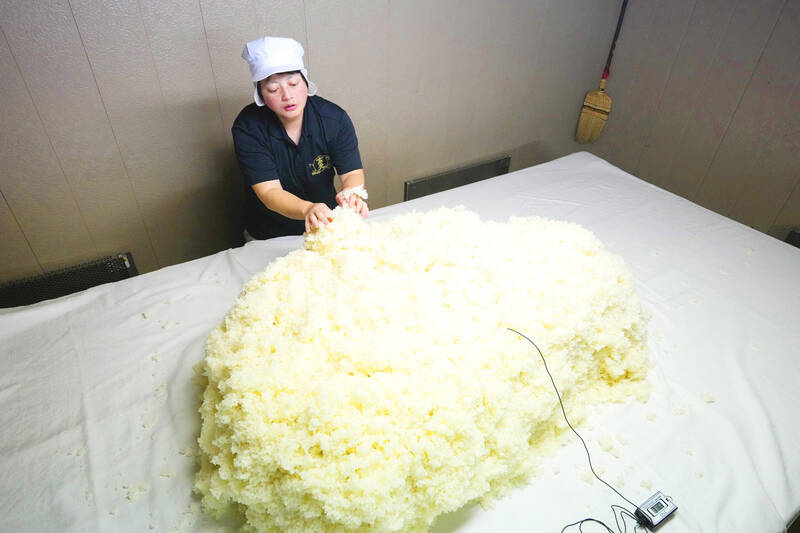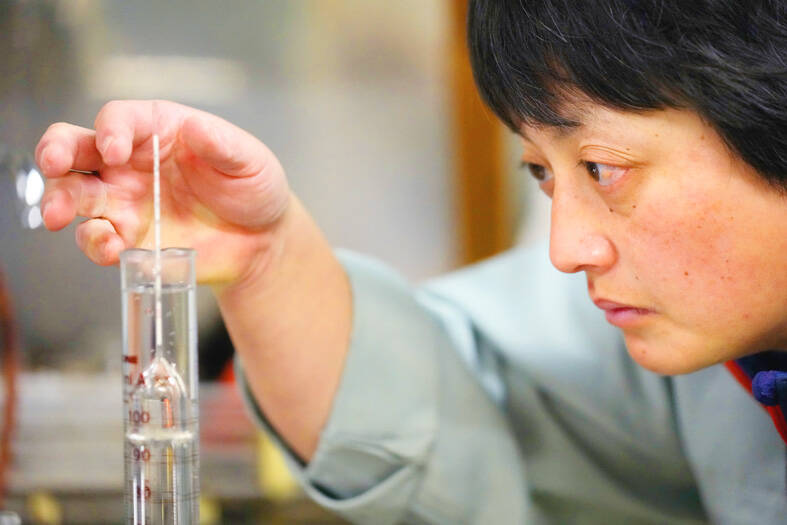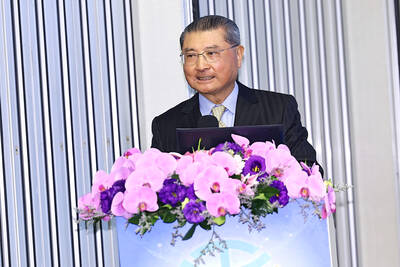Not long after dawn, Japanese sake brewer Mie Takahashi checks the temperature of the mixture fermenting at her family’s 150-year-old sake brewery, Koten, nestled in the foothills of the Japanese Alps.
She stands on an uneven narrow wooden platform over a massive tank containing more than 3,000 liters of a bubbling soup of steamed rice, water and a rice mold known as koji, and gives it a good mix with a long paddle.
“The morning hours are crucial in sake making,” Takahashi, 43, said.

Photo: AP
Her brewery is in Nagano Prefecture, a region known for its sake making.
Takahashi is one of a small group of female toji, or master sake brewers. Only 33 female toji are registered in Japan’s Toji Guild Association out of more than a thousand breweries nationwide.
Women were largely excluded from sake production until after World War II.

Photo: AP
Sake making has a history of more than 1,000 years, with strong roots in Japan’s traditional Shinto religion.
However, when the liquor began to be mass produced during the Edo period, from 1603 until 1868, an unspoken rule barred women from breweries.
The reasons behind the ban remain obscure. One theory is that women were considered impure because of menstruation and were therefore excluded from sacred spaces, said Yasuyuki Kishi, vice director of the Sakeology Center at Niigata University.
“Another theory is that, as sake became mass produced, a lot of heavy labor and dangerous tasks were involved,” he said. “So, the job was seen as inappropriate for women.”
However, the gradual breakdown of gender barriers, coupled with a shrinking workforce caused by Japan’s fast-aging population, has created space for more women to work in sake production.
“It’s still mostly a male-dominated industry. But I think now people focus on whether someone has the passion to do it, regardless of gender,” Takahashi said.
She believes mechanization in the brewery is also helping to narrow the gender gap. At Koten, a crane lifts hundreds of kilograms of steamed rice in batches and places it onto a cooling conveyor, after which the rice is sucked through a hose and transported to a separate room dedicated to cultivating koji.
“In the past, all of this would have been done by hand,” Takahashi said. “With the help of machines, more tasks are accessible for women.”
Sake, or nihonshu, is made by fermenting steamed rice with koji mold, which converts starch into sugar. The ancient brewing technique was recognized under UNESCO’s Intangible Cultural Heritage earlier this month.
As a child, Takahashi was not allowed to enter her family-owned brewery. However, when she turned 15, she was given a tour of the brewery for the first time and was captivated by the fermentation process.
“I saw it bubbling up. It was fascinating to learn that those bubbles were the work of microorganisms that you can’t even see,” said Takahashi, who could not drink alcohol at the time, because she was underage. “It smelled really good. I thought it was amazing that this wonderful fragrant sake could be made from just rice and water. So, I thought I’d like to try making it myself.”
She pursued a degree in fermentation science at the Tokyo University of Agriculture. After graduation, she decided to return home to become a master brewer. She trained for 10 years under the guidance of her predecessor, and at the age of 34 became a toji at her family brewery.
As the brewery enters the winter peak season, Takahashi oversees a team of seasonal workers and production ramps up. It is labor-intensive work, hauling and turning large amounts of heavy steamed rice, and mixing thousands of liters of brew. The master brewer must have the knowledge and skill to carefully control optimal koji mold growth, which needs round-the-clock monitoring.
Despite the intensity, Takahashi manages to encourage camaraderie in the brewery, catching up with the team as they hand-mix koji rice side by side in a hot humid room.
“I was taught that the most important thing is to get along with your team,” Takahashi said. “A common saying is that if the atmosphere in the brewery is tense, the sake will turn out harsh, but if things are going well in the brewery, the sake will turn out smooth.”
The inclusion of women plays an important role in the survival of the Japanese sake industry, which has seen a steady decline since its peak in the 1970s.
Domestic alcoholic consumption has dropped, while many smaller breweries struggle to find new master brewers. According to the Japan Sake and Shochu Makers Association, today’s total production volume is about a quarter of what it was 50 years ago.
To remain competitive, Koten is among many Japanese breweries trying to find a wider market both domestically and abroad.
“Our main product has always been dry sake, which local people continue to drink regularly,” said Takahashi’s older brother, Isao Takahashi, who is in charge of the business side of the family operation.
“We’re now exploring making higher value sake as well,” Isao Takahashi said.
He supports his sister’s experiments — every year she creates a limited-edition series, Mie Special, that is meant to branch out from their signature dry product.
“My sister would say she wants to try to make low alcohol content, or she wants to try new yeasts — all kinds of new techniques are coming in through her,” he said. “I want my sister to make the sake she wants, and I want to do my best to sell it.”

When an apartment comes up for rent in Germany’s big cities, hundreds of prospective tenants often queue down the street to view it, but the acute shortage of affordable housing is getting scant attention ahead of today’s snap general election. “Housing is one of the main problems for people, but nobody talks about it, nobody takes it seriously,” said Andreas Ibel, president of Build Europe, an association representing housing developers. Migration and the sluggish economy top the list of voters’ concerns, but analysts say housing policy fails to break through as returns on investment take time to register, making the

‘SILVER LINING’: Although the news caused TSMC to fall on the local market, an analyst said that as tariffs are not set to go into effect until April, there is still time for negotiations US President Donald Trump on Tuesday said that he would likely impose tariffs on semiconductor, automobile and pharmaceutical imports of about 25 percent, with an announcement coming as soon as April 2 in a move that would represent a dramatic widening of the US leader’s trade war. “I probably will tell you that on April 2, but it’ll be in the neighborhood of 25 percent,” Trump told reporters at his Mar-a-Lago club when asked about his plan for auto tariffs. Asked about similar levies on pharmaceutical drugs and semiconductors, the president said that “it’ll be 25 percent and higher, and it’ll

CHIP BOOM: Revenue for the semiconductor industry is set to reach US$1 trillion by 2032, opening up opportunities for the chip pacakging and testing company, it said ASE Technology Holding Co (日月光投控), the world’s largest provider of outsourced semiconductor assembly and test (OSAT) services, yesterday launched a new advanced manufacturing facility in Penang, Malaysia, aiming to meet growing demand for emerging technologies such as generative artificial intelligence (AI) applications. The US$300 million facility is a critical step in expanding ASE’s global footprint, offering an alternative for customers from the US, Europe, Japan, South Korea and China to assemble and test chips outside of Taiwan amid efforts to diversify supply chains. The plant, the company’s fifth in Malaysia, is part of a strategic expansion plan that would more than triple

Taiwanese artificial intelligence (AI) server makers are expected to make major investments in Texas in May after US President Donald Trump’s first 100 days in office and amid his rising tariff threats, Taiwan Electrical and Electronic Manufacturers’ Association (TEEMA, 台灣電子電機公會) chairman Richard Lee (李詩欽) said yesterday. The association led a delegation of seven AI server manufacturers to Washington, as well as the US states of California, Texas and New Mexico, to discuss land and tax issues, as Taiwanese firms speed up their production plans in the US with many of them seeing Texas as their top option for investment, Lee said. The